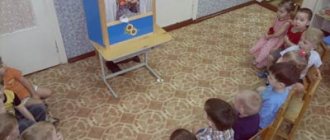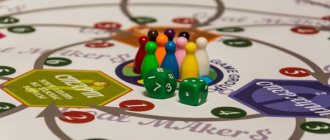Article:
The play activity of preschool children is a significant social phenomenon in which the development and culture of society as a whole are noticeably reflected.
In the process of play, the child reproduces models of adult life, work and relationships, and also realizes his cognitive, aesthetic and moral needs. It is the game that allows the child, over time, to minimize the existing contradictions between his aspirations to be a full-fledged participant in the adult world and the real opportunities available.
In addition to the fact that play takes up a significant part of a child’s free time, it serves as a means for qualitative changes in his self-awareness.
Development of play activities of preschoolers
The development of play activity in preschoolers is primarily manifested in role-playing character. Features of role-playing games are the use of some objects as substitutes for others, individualization of one’s own actions and comparison of them with the actions of adults.
Close adults become models for the child’s playful behavioral reactions. The difference between the games of children of senior preschool age and younger groups is that now the center of their play world becomes a person, a society of people, their actions and relationships with each other. Directly or indirectly, it is adults who play a coordinating role in children's play.
In the gaming activity of preschoolers, the process often becomes more important than the result, and its quality is determined by the number of emotional and cognitive achievements obtained during the game. Often, a child directly or indirectly quotes the point of view of adults on the issues raised in the game, and in gaming relationships with friends he models their actions. Often, as a game plot, children tend to choose those issues that the adults close to them have to solve. Of course, they also use obvious or imaginary objects from the practice of adult life as play objects.
It is extremely important that the plots of the play activities of preschool children are not predetermined in advance; they are formed in real time by the children's collective imagination, thereby developing it. Quite often during the game, certain objects change their functions and begin to play different roles.
In the process of plot-role-playing activities of preschoolers, children's imagination forms images that are embodied through the development of game events. In addition to the plot, such a game has content, certain rules, provides for certain game actions, role-playing relationships, which often turn into real ones, as well as true objects and their substitutes.
Roles are an integral part of preschoolers' play. They reflect a child’s view of the behavior of adults in certain situations and the norms accepted in society. For play, children can choose both areas of adult life that are well known to them, and those that are of lively positive interest and stimulate reflection.
When playing with peers, the child is forced to take into account the point of view of other people or even entire groups, understand and accept their position and look at events through their eyes. For example, by trying on the role of a mother, a girl learns to comprehend feelings of responsibility and care, and begins to understand the role of obedience and mutual understanding.
Program tasks of gaming activities
Yana Vasilyeva
Program tasks of gaming activities
Development of gaming activities
Second group of early age (2-3 years)
Role-playing games. Teach children to show interest in the playful activities of their peers; help play nearby, do not interfere with each other.
Learn to perform several actions with one object and transfer familiar actions from one object to another; with the help of an adult, perform several game actions united by a plot outline. Promote children’s desire to independently select toys and attributes for play, and use substitute items.
Lead children to understand the role in the game. Form initial skills of role behavior; learn to connect plot actions with the role.
Develop the prerequisites for creativity.
Outdoor games. To develop in children a desire to play outdoor games with simple content together with the teacher. Get used to playing together in small groups. Support games that improve movement (walking, running, throwing, rolling)
.
Theatrical games. Arouse interest in theatrical play through the first experience of communicating with a character (the Katya doll shows
concert, expanding contacts with adults (grandmother invites you to the village yard)
.
Encourage children to respond to games-actions with sounds (living and inanimate nature, imitate the movements of animals and birds to music, to the sound of a word (in works of small folklore forms)
.
Promote the manifestation of independence and activity in playing with toy characters.
Create conditions for the systematic perception of theatrical performances of the pedagogical theater (adults)
.
Didactic games. To enrich children’s sensory experience in games with didactic material. Consolidate knowledge about the size, shape, color of objects. Learn to assemble a pyramid (tower)
of 5–8 rings of different sizes; navigate the relationships between plane figures
“Geometric mosaic”
(circle, triangle, square, rectangle)
;
make a whole from four parts (cut pictures, folding cubes)
;
compare, correlate, group, establish the identity and difference of homogeneous objects according to one of the sensory attributes (color, shape, size)
.
Conduct didactic games to develop attention and memory ( “What’s missing?”
and so on.);
auditory differentiation ( “What sounds?”
, etc.);
tactile sensations, temperature differences ( “Wonderful bag”
,
"Warm - cold"
,
“Light - heavy”,
etc.);
fine motor skills (toys with buttons, hooks, zippers, lacing, etc.)
.
Junior group (3-4 years old)
Role-playing games. To encourage children to develop games on themes from life around them, based on literary works (rhymes, songs, fairy tales, poems)
;
enriching gaming experience by combining individual actions into a single storyline.
Develop the ability to choose a role, perform several interrelated actions while playing with toys (cook dinner, set the table, feed)
.
Learn to interact in stories with two characters (driver - passenger, mother - daughter, doctor - patient)
; in individual games with substitute toys, play the role for yourself and for the toy.
Show ways of role-playing behavior using educational games. Encourage children to try to independently select attributes for a particular role; supplement the game environment with missing items,
toys.
To complicate and enrich the subject-game environment through the use of multifunctional items and an increase in the number
toys. Teach children to use building materials in games (cubes, bars, plates, simple wooden and plastic construction sets, natural materials (sand, snow, water)
; act with them in a variety of ways (build a slide for dolls, a bridge, a road; sculpt a fence or house out of snow; float toys on water).
Develop the ability to interact and get along with each other in short-term joint games.
Outdoor games. To develop children’s activity in motor activities . Organize games with all the children in the group. Encourage games with wheelchairs, cars, carts, bicycles; games that develop climbing and crawling skills; games with balls, spheres, developing dexterity of movements.
Gradually introduce games with more complex rules and changing types of movements.
Theatrical games. Arouse children's interest in theatrical play, create conditions for its implementation. To develop the ability to follow the development of action in dramatization games and puppet shows created by adults and older children.
Teach children to imitate the characteristic actions of characters (birds fly, a kid jumps, convey the emotional state of a person (facial expressions, posture, gesture, movement)
.
Introduce children to the techniques of driving tabletop dolls. Learn to accompany movements with a simple song.
Create a desire to act with costume elements (hats, collars, etc.)
and attributes as external symbols of the role.
Develop the desire to improvise on simple plots of songs and fairy tales. Create a desire to perform in front of dolls and peers,
arranging the venue for the performance.
Encourage participation in conversations about the theater (theater - actors - spectators, behavior of people in the auditorium)
.
Didactic games. Strengthen children’s ability to select objects by color and size (large, medium and small balls of 2-3 colors, assemble a pyramid of rings of decreasing size, alternating 2-3 colors in a certain sequence. Teach to assemble a picture from 4-6 parts ( “ Our dishes"
,
“Toys”
, etc.).
In joint didactic games, teach children to follow gradually more complex rules.
Middle group (4 -5 years old)
Role-playing games. Continue working with children to develop and enrich the plots of games; Using indirect methods of guidance, lead children to independently create game plans .
In joint games with the teacher, containing 2-3 roles, improve the children’s ability to unite in the game, distribute roles (mother, father, children, perform game actions , act in accordance with the rules and the general game plan .
Learn to select objects and attributes for the game.
Develop the ability to use buildings made from building materials in a role-playing game. Encourage children to create buildings of varying structural complexity (for example, a garage for several cars, a house of 2-3 floors, a wide bridge for the passage of cars or trains going in two directions, etc.).
Teach children to agree on what they will build, distribute material among themselves, coordinate actions and achieve results through joint efforts.
Nurture friendly relationships between children, develop the ability to take into account the interests of comrades.
Expand the scope of children’s independent actions in choosing a role, developing and implementing a plan, and using attributes; develop the social relationships of those playing by understanding the professional activities of adults .
Outdoor games. Continue to develop physical activity; agility, speed, spatial orientation.
To foster children's independence in organizing familiar games with a small group of peers.
Train yourself to follow rules independently.
Develop children’s creative abilities in games (inventing game options, combining movements)
.
Theatrical games. Continue to develop and maintain children’s interest in theatrical play by acquiring more complex gaming skills (the ability to perceive an artistic image, monitor the development and interaction of characters).
Conduct studies to develop the necessary mental qualities (perception, imagination, attention, thinking, performance skills (role-playing, ability to act in an imaginary plan)
and sensations (muscular, sensory, using musical, verbal, visual images.
Teach children to perform simple performances based on familiar literary works; use to embody an image
known means of expression (intonation, facial expressions, gesture)
.
Encourage children to show initiative and independence in choosing a role, plot, and means of transformation; provide the opportunity for experimentation when creating the same image.
To learn to feel and understand the emotional state of the hero, to enter into role-playing interactions with other characters.
To promote the diversified development of children in theatrical activities by tracking the number and nature of the roles performed by each child.
Promote the further development of director's play by providing space, play materials and the opportunity for several children to join together for long periods of play.
To teach the use of figurative toys and bibabo, independently sculpted figures from clay, plastic, plasticine, and toys from Kinder surprises in theatrical games.
Continue to use the capabilities of the pedagogical theater (for adults)
for the accumulation of emotional and sensory experience, for children to understand the complex of expressive means used in the performance.
Didactic games. Learn to play didactic games aimed at consolidating ideas about the properties of objects, improving the ability to compare objects by external characteristics, group, and make a whole from parts (cubes, mosaics, puzzles)
.
Improve tactile, auditory, and taste sensations (“Identify by touch (by taste, by sound)
").
Develop observation and attention ( “What has changed”
,
“Who has the ring”
).
Encourage the desire to master the rules of the simplest board games ( “Domino”
,
"Lotto"
).
Senior group (5-6 years old)
Role-playing games. Improve and expand play ideas and skills. Develop a desire to organize role-playing games.
Encourage the choice of a theme for the game; teach to develop a plot based on knowledge gained from the perception of the environment, from literary works and television programs, excursions, exhibitions, travel, hikes.
Teach children to agree on the theme of the game; distribute roles, prepare the necessary conditions, agree on the sequence of joint actions, establish and regulate contacts in a joint game: negotiate, reconcile, give in, convince, etc. Learn to independently resolve conflicts that arise during the game. Contribute to the strengthening of sustainable children's play associations .
Continue to develop the ability to coordinate your actions with
actions of partners, observe role interactions and relationships in the game. Develop emotions that arise during role-playing and plot game actions with characters.
Learn to complicate the game by expanding the composition of roles, coordinating and predicting role actions and behavior in accordance with the plot of the game, and increasing the number of combined storylines.
Contribute to enriching a familiar game with new solutions (participation of an adult, changing attributes, introducing substitute items or introducing a new role). Create conditions for creative self-expression; for the emergence of new games and their development.
Teach children to collectively build buildings necessary for the game, plan upcoming work, and carry out their plans together. Learn to apply constructive skills acquired in class.
Form the habit of carefully putting toys away in the designated place.
Outdoor games. Continue to teach children to independently organize familiar outdoor games; participate in games with competitive elements. Introduce folk games.
Cultivate honesty and fairness in independent games with peers.
Theatrical games. Continue to develop interest in
theatrical play by actively involving children in play activities . Create a desire to try yourself in different roles.
To complicate the game material by presenting more and more promising ones to the children (from the point of view of dramaturgy)
artistic
tasks ( “You were poor Cinderella, and now you are a beautiful princess”
,
“This role has not yet been revealed to anyone”
, changing tactics of working on
a game or performance.
Create an atmosphere of creativity and trust, giving each child the opportunity to speak out about the preparation for the performance and the process of the game.
Teach children to create creative groups to prepare and conduct performances and concerts, using all available opportunities.
Learn to build a line of behavior in a role using attributes and costume details made with your own hands.
Encourage improvisation and the ability to feel free in a role. To cultivate artistic qualities, to reveal the creative potential of children, involving them in various theatrical performances: concert games, circus, showing scenes from plays. Provide opportunities for children to perform in front of peers, parents, and others
guests.
Didactic games. Organize didactic games, uniting children into subgroups of 2–4 people; learn to follow the rules of the game.
Develop memory, attention, imagination, thinking, speech, sensory abilities of children. Learn to compare objects, notice minor differences in their characteristics (color, shape, size, material, combine objects according to common characteristics, make a whole from parts (folding cubes, mosaics, puzzles, identify changes in the arrangement of objects (front, back, right, left) , under, above, in the middle, on the side)
.
To develop a desire to act with a variety of educational games and toys (folk, electronic, computer games, etc.)
.
Encourage children to be independent in the game, causing them to have an emotionally positive response to the game action .
Teach to obey the rules in group games. Foster creative independence. Develop qualities such as friendliness and discipline. Foster a culture of fair competition in competitive games.
School preparatory group (6-7 years old)
Continue to develop children's independence in organizing all types of games, following rules and norms of behavior.
Develop initiative and organizational skills. Foster a sense of teamwork.
Role-playing games. Continue to teach children to take on different roles in accordance with the plot of the game; use attributes, constructors, building materials.
Encourage children to organize their own game in their own way, independently select and create the items missing for the game (tickets for playing in the theater, money for shopping)
.
To promote the creative use in games of ideas about the surrounding life, impressions of works of literature, and cartoons.
Develop creative imagination, the ability to develop a game together, coordinating your own game plan with the plans of your peers; continue to develop the ability to negotiate, plan and discuss the actions of all players.
Form relationships based on cooperation and mutual assistance. Cultivate goodwill and willingness to help a peer; the ability to take into account the interests and opinions of fellow players and resolve disputes fairly.
Outdoor games. Teach children to use outdoor games of various content in their independent activities. Conduct games with elements of competition that promote the development of physical qualities (dexterity, speed, endurance, coordination of movements, ability to navigate in space.
Learn to fairly evaluate the results of the game.
Develop interest in sports (badminton, basketball, table tennis, hockey, football)
and folk games.
Theatrical games. To develop children's independence in organizing theatrical games.
Improve the ability to independently choose a fairy tale,
poem, song for production; prepare the necessary attributes and scenery for the future performance; distribute responsibilities and roles among themselves.
Develop creative independence, aesthetic taste in conveying an image; artistic skills. Learn to use means of expression (posture, gestures, facial expressions, intonation, movements)
.
Cultivate a love of theater. Widely use different types of theater in children's theatrical activities (bibabo, finger theater, cup theater, picture theater, glove theater, puppet theater, etc.).
To develop the skills of theatrical culture, to introduce them to theatrical and musical art through watching theatrical performances and video materials. Tell children about the theater and theatrical professions.
Learn to comprehend artistic images created by means of theatrical expressiveness (lighting, makeup, music, words, choreography, scenery, etc.)
.
Didactic games. Continue teaching children to play various educational games (lotto, mosaic, spillikins, etc.)
. Develop the ability to organize games and play the role of a leader.
Learn to coordinate your actions with the actions of the leader and other participants in the game. Develop intelligence in the game, the ability to independently solve a given problem .
Involve children in creating some didactic games ( “Noisemakers”
,
“Rustlers”
, etc.). Develop and consolidate sensory abilities. Promote the manifestation and development in the game of qualities necessary for preparing for school: voluntary behavior, associative figurative
and logical thinking, imagination, cognitive activity.
Play interests of preschoolers
Games with a professional theme, through the attractiveness of a particular type of activity, help to understand the motivation of people’s work, its importance and high degree of responsibility. The child is able to understand what a particular specialist does at his workplace. It is believed that the average older preschooler, through play, is familiar with at least ten professional areas, despite the fact that he considers no more than two of them to be the closest to himself.
The rules of play activity for preschool children dictate certain boundaries of behavior for the characters. Thus, the child is partly guided by his own position, but mainly learns to act in the given circumstances and restrain his own desires.
Compliance with the rules of the game refers to the conscious social actions of a growing person. Rules allow for control and self-control. In the process of growing up, a child changes his attitude towards the rules of the game from their complete rejection in early preschool age to active displeasure when such rules are ignored by peers already on the eve of school.
It is remarkable that preschoolers create the rules of the game based on the logic of life connections familiar to them, and their implementation is considered a necessity.
A prerequisite for the play activity of preschool children is the imaginary nature of the situation. Depending on how broad a child’s horizons are, he is able to imitate various areas of adult activity: family life, space flights, construction, and others. The more stories a preschooler is able to offer for play, the longer the game becomes.
Children 5-6 years old are able to concentrate on a game plot for several hours and even days. Also, as they grow older, they give preference to certain game situations. While in younger preschool age everyday topics predominate, on average, production circumstances are of greater interest, and older preschoolers are captivated by socio-political scenarios, often intertwined with the plots of their favorite films or books.
The development of play activity in preschoolers shows noticeable progress as children move from one age group to another. Kids are not able to plan the development of the plot, and more often repeat the same actions of adults (washing dishes, making Easter cakes, etc.). Older children demonstrate creativity, and consider the relationships between players to be the most important in the game. Older children value the distribution of roles and adherence to the rules of the game.
Play as the main type of activity for a preschooler
It is at this stage that it is possible to develop play creativity under the influence of education and training, since its development depends on the acquisition of knowledge and skills, on the cultivation of interests. The teacher can replace the child’s individual characteristics that manifest themselves in the game. At the same time, it is observed that the same child exhibits different levels of play creativity depending on the content of the game, the role performed, and relationships with friends
1.3 CHARACTERISTICS OF THE MAIN TYPES OF GAMES AND THEIR CLASSIFICATION
Children's games are very diverse. They differ in content and organization, rules, the nature of children’s manifestations, the impact on the child, the types of objects used, origin, etc. All this makes it difficult to classify games, but for proper management of games, grouping them is necessary. Each type of game performs its own function in the development of a child. In preschool age, there are three classes of games:
- games that arise on the child’s initiative - amateur games;
- games that arise on the initiative of an adult who introduces them for educational and educational purposes;
- games that come from the historically established traditions of the ethnic group - folk games that can arise both on the initiative of an adult and older children.
Each of the listed classes of games, in turn, is represented by types and subtypes. So, the first class includes:
1.Creative role-playing games.
The concept of “creative play” covers role-playing games, dramatization games, and construction games. The content of creative games is invented by the children themselves. Freedom, independence, self-organization and creativity of children in this group are especially fully manifested. Various life experiences are not copied, they are processed by children, some of them are replaced by others, etc.
- role-playing game
- This is the main type of game for a preschool child. It has the main features of the game: emotional richness and enthusiasm of children, independence, activity, creativity. The first story games proceed as role-less games or games with a hidden role. Children's actions acquire a plot character and are combined into a chain that has vital meaning. Actions with objects and toys are carried out by each of the playing children independently. Joint games are possible with the participation of an adult. [14, p.14]
- dramatization games
. They have the main features of creative games: the presence of a plan, a combination of role-playing and real actions and relationships, and other elements of an imaginary situation. Games are built on the basis of a literary work: the plot of the game, roles, actions of the characters and their speech are determined by the text of the work. Dramatization play has a great influence on a child’s speech. The child assimilates the riches of his native language, its means of expression, uses various intonations that correspond to the character of the characters and actions, and tries to speak clearly so that everyone understands him. The beginning of work on a dramatization game consists of selecting a work of art. It is important that it interests children and evokes strong feelings and experiences. The teacher takes part in the conspiracy and preparation of the game. Based on the content of the work, the plot of the game is drawn up with the children, roles are assigned, and speech material is selected. The teacher uses questions, advice, re-reading the work, conversations with children about the game and thus helps to achieve the greatest expressiveness in the depiction of the characters.
Teaching games to preschool children
When teaching the game to preschool children, it is necessary to take into account several aspects. First of all, it should be understood that the context of the game allows a child of primary school age to act holistically, in accordance with the proposed circumstances. Only after having gained sufficient experience with the help of this kind of games, an older child is able to identify the problems of the game, and therefore perceive the tasks assigned to him in a playful form. When teaching the game to preschool children of older groups, it should be based on the already formed skills of their collective activity.
Purpose, objectives and principles of organizing gaming activities
The professional skill of a teacher of additional education is manifested in the fact that he must be able to organize the activities of students, develop their creative abilities and individuality through play. G.K. Selevko identifies a whole range of target orientations: - Didactic
: broadening one’s horizons, cognitive activity, formation of certain skills and abilities, development of labor skills.
— Educational
: nurturing independence, will..., moral, aesthetic positions, nurturing cooperation, collectivism, sociability, communication.
— Developmental
: development of attention, memory, speech, thinking, skills to compare, contrast, imagination, fantasy, creativity, empathy, development of motivation for educational activities, —
Socializing
: familiarization with the norms and values of society; adaptation to environmental conditions; stress control, self-regulation; communication training, psychotherapy.
Tasks of gaming activity
carried out by the teacher may be as follows: - development of communicative qualities in children in play; — development of imagination as the basis of creative activity; - development of figurative memory, attention, speech in children; — formation of non-standard thinking during games; — development of coordination and fine motor skills; — organization of collective and individual games during classes, exercises and creative gaming tasks; — based on the goals and objectives that determine play activities, principles should be noted as regulatory requirements for organizing children’s play. The nature of the principles is expressed in the form of general instructions, rules, norms.
Let's consider the principles of organizing gaming activities formulated by P.I. Pidkasisty and Zh.S. Khaidarov. The authors outlined a fairly extensive list of game principles. Let us dwell on the most significant and relevant institutions of additional education for teachers: - activity
— the basis is the principle of gaming activity, expressing the active manifestation of physical and intellectual forces, starting with preparation for the game, during the process and during the discussion of its results;
— openness and accessibility
of the game means free participation of those interested, and any game should be simple and understandable;
— dynamism
expresses the importance and influence of the time factor in the game.
The duration of the game is significant for the age of the children and their level of preparedness; — the visibility
of the game means that all game actions must be open in real and surreal (cinema, theater, computer games) manifestations of a particular reality, which significantly increases cognitive interest;
— the entertaining and emotional nature
of the game reflects exciting, interesting manifestations of gaming activity and significantly enhances cognitive interest;
— the principle of individuality
reflects a purely personal attitude to the game, where personal qualities develop and there is an opportunity for self-expression and self-affirmation of the player;
— collectivity
reflects the joint nature of interconnected and interdependent gaming activities, promotes the development of friendly relationships, teaches them to think and act together;
— determination
reflects the unity of purpose for the player and his opponent;
personal goals must coincide with the overall goals of the team; - initiative and independence
of the player in the game - this is one of the main principles, it has a control function expressed in the relationship between the measure of initiative and the measure of independence;
- competitiveness and competition
in the game.
Without competition there is no game. The didactic value of this principle is obvious, because encourages active independent activity, mobilizes physical, intellectual and mental strength; — effectiveness
reflects awareness of the results of game actions as productive creative activity of the player and the team;
— the reliability and repeatability
of the game is manifested in the fact that almost all of them are based on real models and roles.
This allows you to repeat the past and “open up” the certainty of the future. Therefore, the game is a powerful forecasting tool; — the principle of problematic nature
in the game expresses the logical and psychological patterns of thinking in the intellectual and emotional struggle.
The game is an “ideal generator” of educational problems, and the ability to “see and do” problems where there are none for opponents leads to victory in the game, and in life; - information
for the game in its simplest form reflects the player’s strong emotional excitement in anticipation of success or defeat, etc.
Thus, a holistic, interconnected application of the principles of effective organization of gaming activities can guarantee a high didactic, educational and developmental influence on the players.
Related Sections
|





